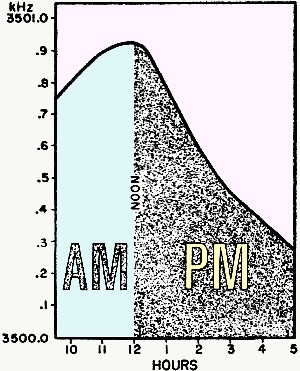 [Table of Contents] [Table of Contents]
People old and young enjoy waxing nostalgic about and learning some of the history
of early electronics. Popular Electronics was published from October 1954
through April 1985. All copyrights (if any) are hereby acknowledged. See
Popular Electronics
articles on aircraft modeling. See all articles from
Popular Electronics.
|
This is pretty cool.
If I owned a good receiver, I would definitely give it a try. In 1970 when this
Popular Electronics magazine article was written, a lot of Hams were still using
vacuum tube receivers
so the recommendation to let the equipment warm up for several hours prior to making
the fine frequency adjustments was good advice. Nowadays the warm-up time and stability
of receivers should permit 30 minutes or so to suffice (even ovenized frequency
references need time to stabilize when first powered up). Unless I missed it, the
author does not explicitly state that the frequency change measured over time is
due to gravity acting on the mass of the crystal reference, but I suspect that is
his intention since part of the experiment involves disconnecting the antenna and
shielding the receiver from outside interferers. Over a
lunar month
period (29.5 days) we experience a leap tide and a neap tide which maximizes and
minimizes, respectively, the vector sum of gravity and therefore should result in
the greatest excursions. Maybe with a super-stable source, a larger scale phenomenon
such as a planetary syzygy could be detected (but I doubt it).
An Experiment with Gravity - Chart These Strange Forces with Your Receiver

Sample graph shows the plot of frequency changes versus time.
Note that plot-ted line peaks out shortly after noon.
By Commander Thomas ApplebyWe are all familiar with the natural phenomenon known as gravity; but most of
us tend to think of gravity on the surface of the earth as being constant. In fact,
it is always changing in magnitude, due mainly to the forces exerted on the earth
by the sun and the moon. The variations are, of course, so minute that only in the
past few years have they been detected by specially designed, highly sensitive instruments.
Oddly enough, my years of research into the phenomenon have shown that the average
ham radio CW receiver can apparently "detect" changes in gravity.
The effects of gravity on a receiver might account for its drifting off frequency.
Even after communications receivers have had time to become thoroughly temperature
stabilized, frequency drifting and periodic returning are common occurrences.
Taking advantage of the effects the forces of the sun and the moon have on the
earth's gravity, you can experiment on your own. All you need is a receiver with
an ultra-fine scale on its tuning dial. (One that has 10 divisions for each minor
division on the main tuning dial scale.) Remember that gravity variations are on
the order of only 10-6 part
of the weight of the mass in which they are produced. Although the effect of the
variations is greatly amplified by your receiver, the end result is still minute.
To perform the experiment, disconnect the antenna and any other leads that might
pick up a signal at either 3500 or 7000 kHz. In the morning, set the tuning
dial of your CW receiver to either of the above frequencies and adjust the BFO for
zero beat.
Allow the receiver to warm up for several hours. Then reset the BFO for zero
beat. Every half hour or so after this, see if it is necessary to retune for zero
beat. Record the new dial setting and make up a graph similar to that shown here.
The frequency changes you record will be very small so use an expanded scale.
The recorded frequency variations will increase or decrease, depending on whether
the magnitude of gravity is increasing or decreasing, respectively. You will notice
that after the sun or moon passes the zenith, the curve will begin to bend downward.
Also, the curve will change from day to day because of variations in the orbits
of the sun and the moon.
************
"A completely new branch of astronomy is opening up with the recent discovery
of gravitational waves by Dr. Joseph Weber of the University of Maryland. The force
of gravity is the most fundamental and least understood force in the universe; confirmation
that gravity varies will be detected may well turn out to be as important as the
discovery of radio waves by Heinrich Hertz in 1887."
-The Industrial Bulletin, Arthur D. Little, Inc.
************
|



